So I know that there has been a video about this before but this new one by Greenman3610 is extremely well researched and as with all of his videos is very well expressed.
Friday, April 29, 2011
Thursday, April 28, 2011
Golden Crocoduck Nominee #1
So Potholer54 has moved the Golden Crocoduck award from his other channel to his main one and here is the first nominee for the 2011 award. Let me say that the group that is the first nominee put together a pretty trippy movie for both children and especially for a creationist group.
How do you define a human
Saturday, April 23, 2011
Support Science in Louisiana
The Louisiana Coalition for Science post from earlier today talks about the efforts to repeal the hidden creationist agenda in a law, Louisiana Science Education Act. Go to there post to read more. I have obviously been against this bill since its inception a lot of that was because I lived in Louisiana at the time. Living in Lubbock, Texas and having to attend school and work out here will make it so I can not make it to Baton Rouge for the rally but if you are in the area make sure you go and support the effort to repeal the LSEA.
A Future for Bats
So yesterday I had a post about Mammoth Cave National Park and I focused primarily on the geology of the park as I have with most of my National Park posts. Well shortly after I posted it I read a post over at Darren Naish's wonderful blog Tetrapod Zoology in his 20 part (holy crap 20) series on vesper bats, the link to the post will include links to the other 19 if you want. This was the last post in series and it is about the potential future for vesper bats and it included a pretty good summary of all of the troubles that the vesper bats are currently facing. This post won't focus on vesper bats in particular but bats in the more general sense
Now to tie the previous paragraph together. When I visited Mammoth Cave much of the discussion by the tour guides was not about the geologic history, although there was plenty of that, it was about the animals that live in the caves especially the bats. Bats seem to have some hold on people that seems to interest them greatly. They discussed two of the problems that Darren talks about in his post and how the National Park Service is trying to prevent the loss of bats. I will follow the two of them in the same order that Darren did and for simplicities sake I will be using the same section titles.
Disturbance and roost destruction
Many bats hibernate for the winter in caves and in hollow trees among other similar things. One of the things that can cause them not to come back or to leave their hibernation place too early is being disturbed while they hibernating. The U.S. Fish and Wildlife Service (FWS homepage) had this to say on the Indiana Bat, Myotis sodalis.
White-nose syndrome
While the previous section focused primarily on the Indiana bat this section applies more to bats in general. White nose syndrome (WNS) is a deadly disease that is described very well on Darren's post, but I have included the Wikipedia link just in case. WNS is devastating to bat populations and as such the NPS is greatly concerned with it hitting the bat populations within the park on a webpage with a lot of information on WNS:
Now to tie the previous paragraph together. When I visited Mammoth Cave much of the discussion by the tour guides was not about the geologic history, although there was plenty of that, it was about the animals that live in the caves especially the bats. Bats seem to have some hold on people that seems to interest them greatly. They discussed two of the problems that Darren talks about in his post and how the National Park Service is trying to prevent the loss of bats. I will follow the two of them in the same order that Darren did and for simplicities sake I will be using the same section titles.
Disturbance and roost destruction
Many bats hibernate for the winter in caves and in hollow trees among other similar things. One of the things that can cause them not to come back or to leave their hibernation place too early is being disturbed while they hibernating. The U.S. Fish and Wildlife Service (FWS homepage) had this to say on the Indiana Bat, Myotis sodalis.
Indiana bats, because they hibernate in large numbers in only a few caves, are extremely vulnerable to disturbance. During hibernation, they cluster in groups of up to 500 per square foot. Since the largest hibernation caves support from 20,000 to 50,000 bats, it is easy to see how a large part of the total population can be affected by a single event. Episodes of large numbers of Indiana bat deaths have occurred due to human disturbance during hibernation.It is obviously one thing to admit you have a problem and something else completely to do something about it. Well while at the park I was told that many of the other entrances, even the ones outside of the park, had gates put on them that would allow bats and other animals in and out but not allow humans in. The FWS page said this:
Public lands like National Wildlife Refuges, military areas, and U.S. Forest Service lands are managed for Indiana bats by protecting forests. This means ensuring that there are the size and species of trees needed by Indiana bats for roosting; and providing a supply of dead and dying trees that can be used as roost sites. In addition, caves used for hibernation are managed to maintain suitable conditions for hibernation and eliminate disturbance.The National Park Service itself also talks about protection of the bats on page 12 of this report on the biological assessment for fiscal year 2007 prescribed fire plan says this:
There is a preference for standing dead trees and species that have loose bark, but Indiana bats may roost in any tree greater than six inches in diameter (they have occasionally been seen in smaller trees). The cave hibernacula are gated to prevent human disturbance during hibernationAlso in the report they mention not cutting down dead hollowed out trees and just trimming off some of the lower branches to keep the fire from spreading up the tree.
White-nose syndrome
While the previous section focused primarily on the Indiana bat this section applies more to bats in general. White nose syndrome (WNS) is a deadly disease that is described very well on Darren's post, but I have included the Wikipedia link just in case. WNS is devastating to bat populations and as such the NPS is greatly concerned with it hitting the bat populations within the park on a webpage with a lot of information on WNS:
The potential exists for the loss of hundreds of thousands more bats—and perhaps entire species—bad news for us as bats devour millions of insect pests and play a role in pollination.The park, however, is being proactive and on that website they talk about what you should try to do to avoid spreading it. They also include a little check list explaining what you should try to avoid, as well as a small application that allows for a quick, you are good to go or you should see us about this. There were plenty of signs all over the visitors center about the harm white nose syndrome can do and a booth to go visit if you may have come in contact with it. They even have a plan in case your tour group happens across a potential exposure to WNS.
On the remote chance that you might come into contact with Geomyces destructans spores during your tour of Mammoth Cave, all participants in Mammoth Cave National Park cave tours will be required to walk on bio security mats after exiting the Cave. This will require each individual in your party to walk the length of a nylon mat saturated in a Lysol™ solution comparable to that used in home cleaning. Specific information on the active ingredients of Lysol IC™ and the concentration being used are available at the White-Nose Station at the Visitor Center. We also ask for your cooperation by washing your hands and changing clothes and footwear before visiting any other caves or mines.I hope that between the efforts of the NPS in parks such as Mammoth Cave National Park and the efforts of the PWS throughout the United States could slow the spread of WNS and prevent many deaths from people disturbing colonies as possible.
Friday, April 22, 2011
Mammoth Cave National Park

Location: North-central Kentucky in portions of Edmonson, Hart, and Barren counties.
Introduction:
I was originally going to hold this post off till later but in honor of Earth Day and National Park week, many parks will allow you in for free or cheap through Sunday (April 24, 2011), I figured I would get this post done early.
Spring Break 2011 brought me to Nashville, TN and while Tennessee itself is home to many national parks this is the closest one to Nashville. About an hour and a half to two hour long drive from Nashville, Mammoth Cave is also close to other metropolitan areas such as Louisville, KY. Mammoth Cave (Wikipedia page) was the second of the cave systems within the National Parks that I visited, the first was Carlsbad Caverns National Park. Mammoth Cave National Park covers a large area and includes many different areas to hike around outside and enjoy the mountains and the forest. Obviously, however, what the park is most known for is the cave itself which includes at least two different entrances that lead down into the cave.
Unlike Carlsbad this cave system has been known for a long time and as you head through the cave you can see many of the markings made by some of the early visitors to the cave. These marks were made using candles on top of long sticks to allow visitors to write their names in the ash and smoke made from the candles on the roof, and since the cave environment changes very little and the marked areas do not have water in them many names that have been there since the mid-1800s are still visible. This cave has been in use in some form or another since the early 1800s and was originally used as a mine with many of the original settling basins and pipes that were worked by slaves are still visible. The one thing I didn't like about this park was that, also unlike Carlsbad, the only way to view the cave was the be led down by a National Park Service guide. This is due to the cave being more confusing than Carlsbad and the trails having been put in by the Civilian Conservation Corps (CCC) in the 1930's so the trail itself is not paved with railing around it. Overall though if you are in the area I recommend that you check out the cave.
Geology:
 I have already covered how caves form from solid rock in the Carlsbad Caverns post (click that link if you want to read more) so the geology in this post will be more about the regional geology.
I have already covered how caves form from solid rock in the Carlsbad Caverns post (click that link if you want to read more) so the geology in this post will be more about the regional geology.If you look at the mid-western portion of the United States on a geologic map there are a lot of Paleozoic aged rocks that form the bedrock for that area. This is because for most of the Paleozoic the Midwest was sitting under a shallow sea and the Appalachian Mountains were being uplifted, for the first time, which provided sediment to be deposited in this basin. During much of the Paleozoic North America sat on the equator which provided for a much warmer climate than what is found today especially in some of the more northern states such as Pennsylvania, you can see more of this in my Guadalupe Mountains (Guads) post. Many of the southern portions of this area were not receiving high amounts of sediment though and due to the way the crust bent in the area, the Cincinnati arch, these areas, seen really well from just south of Nashville to Ohio, were shallow seas. These shallow warm seas as we know today are home to calcite secreting organism and other reef organisms. This creates a vast area in the center of the country that is home to lots of limestone deposits which creates what is known as karst topography, which is pretty much lots of sink holes and caves. All of the rock that you see in and around Nashville is limestone or other similar calcite rich rocks.
During the Mississippian, early Carboniferous, the area that is now Mammoth Cave National Park was sitting in a shallow sea and was a highly productive reef system. Throughout many areas of the cave fossil organisms that are now primarily associated with reef systems, such as crinoids [image of a crinoid fossil from the new entrance to the left], are found as fossils in some of the less altered cave walls. This led to a lot of deposition of calcite which is where all of the portions of the cave are now found. During the Pennsylvanian, late Carboniferous, there was a subtle change in the flow of sediments into the basin and a river system began depositing sand in a deltaic system over the area. The sediment from this river would choke off the ability of the reef organisms to live and produce calcite, similar to why there are no reefs near the Mississippi River delta today, and would instead allow just for the deposition of sands and clays. These sands and clays do not erode away as quickly or easily nor are they effected by acidic water the same way that limestone is so they provide a sort of cap rock preventing water from entering the system and dissolving away the rocks below.
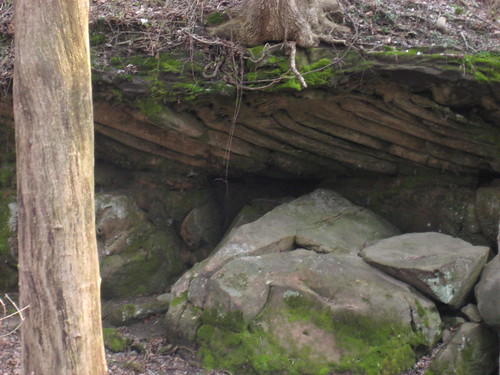 Eventually this area began to uplift as well as forms the western portion of the current Appalachian Mountains called the Appalachian Plateau. As this area was uplifted water did what it always does to areas that are uplifting, it started cutting away where rivers were flowing to form valleys, the speed of this uplift is really present in some of the eastern rivers such as the New River and the Shenandoah which appear to meander like river that are no longer down-cutting but they are still down-cutting forming deep valleys (I have the ability to cover that last one and might here soon). Within Mammoth Cave National Park is the Green River which cuts a valley and at one time was much higher up relative to where it is now. It was when it was still cutting a higher portion of this valley that most of the cave that visitors see was being formed. The cave system itself is actually part of the Green River watershed and there are vast underground flowing rivers that carry water from west of the area over to the current location of the river. At one point in the past some of the larger chambers in the upper portion of the cave did the same but as the water table fell, do to the uplift of the mountains, these portions of the cave became dry. In many places the Pennsylvanian sandstone [image at right is an outcrop of the Pennsylvanian sandstone] that formed the cap rock has been stripped away this has allowed water to continue to enter the cave and forms many of the sinkholes in the area. The places where the sandstone is still present form the ridge tops and locations within the cave that have no water dripping into them, because it cannot get through the sandstone, or does so too slowly to be noticed. This creates a stable environment that allowed for the preservation of mummies that first created the buzz for the area before it was a National Park.
Eventually this area began to uplift as well as forms the western portion of the current Appalachian Mountains called the Appalachian Plateau. As this area was uplifted water did what it always does to areas that are uplifting, it started cutting away where rivers were flowing to form valleys, the speed of this uplift is really present in some of the eastern rivers such as the New River and the Shenandoah which appear to meander like river that are no longer down-cutting but they are still down-cutting forming deep valleys (I have the ability to cover that last one and might here soon). Within Mammoth Cave National Park is the Green River which cuts a valley and at one time was much higher up relative to where it is now. It was when it was still cutting a higher portion of this valley that most of the cave that visitors see was being formed. The cave system itself is actually part of the Green River watershed and there are vast underground flowing rivers that carry water from west of the area over to the current location of the river. At one point in the past some of the larger chambers in the upper portion of the cave did the same but as the water table fell, do to the uplift of the mountains, these portions of the cave became dry. In many places the Pennsylvanian sandstone [image at right is an outcrop of the Pennsylvanian sandstone] that formed the cap rock has been stripped away this has allowed water to continue to enter the cave and forms many of the sinkholes in the area. The places where the sandstone is still present form the ridge tops and locations within the cave that have no water dripping into them, because it cannot get through the sandstone, or does so too slowly to be noticed. This creates a stable environment that allowed for the preservation of mummies that first created the buzz for the area before it was a National Park.More Pictures I have even more in the Mammoth Cave portion of my Flickr page.
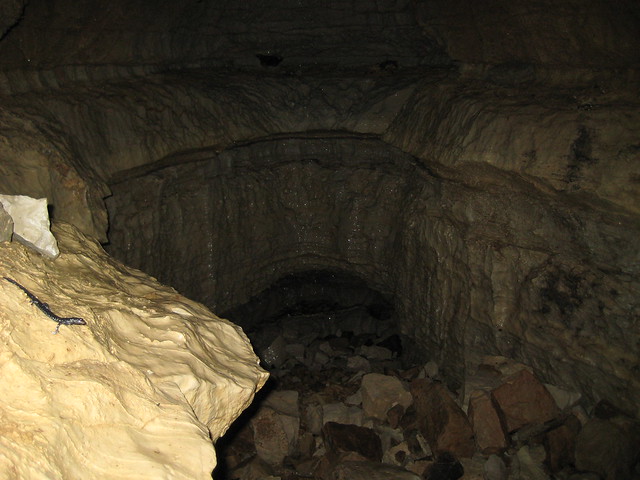
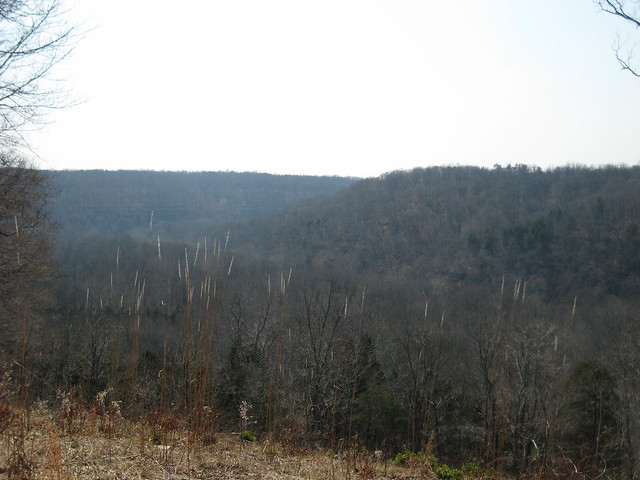
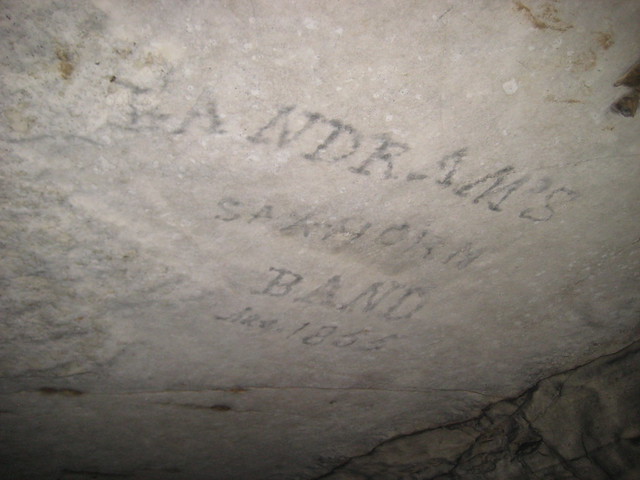
Further Reading:
History of Geology's post on the mountains formed by prehistoric reefs (I should really have linked here in the Guads post as well).
National Park Service's webpage on the Natural Features and Ecosystems which has links to many more specialized sections of their webpage.
My post on how the NPS is trying to protect bats in the area.
National Park Service Series homepage
The Science of MSG
I knew a lot of people thought of MSG as bad for you but I really didn't know why until I watched this video by C0nc0rdance and from the looks of it the science doesn't support the claims probably another case of media hype. I want to point out that C0nc0rdance cites all of the studies he talks mentions in the information below the video so if you want to do your own fact checking make sure to check it out.
Tuesday, April 19, 2011
Ken Ham's take on Fossil Butte
So yesterday the blogger over at The Dispersal of Darwin posted a link to this story on Facebook yesterday. When I saw where it linked I initially didn't think much of it but as I read through the article I wanted to address something. The link leads to Ken Ham being upset about the way that Fossil Butte National Monument (Wikipedia page) handles the age of the Earth.
First, Ken Ham can complain all he wants about this being "indoctrinating visiting families" but I am sorry Ken it isn't. Why do I say this? Well simple there has been no peer-reviewed published scientific paper that 1) disputes evolution, and 2) supports his particular view of a 6 day creation. All evidence right now points to an old Earth one that is ~4.6 billion years old, I am not saying that it may not be proved wrong in the future but it isn't really looking like it. What the NPS is doing is taking the current scientific understanding about the planet and presenting it in a unique way.
This brings me to my second and main point, this is a really cool way to try to teach people about this. As someone who has taught labs on historical geology I am always trying to find a way to help my students understand the age of the Earth. While this may not be useful to everyone to the people visiting Fossil Butte it will help them get a better understanding this great expanse of time. Humans are not good at understanding numbers that big because they really don't mean much to us but by having people drive through this whole length of time might give this huge numbers some meaning, you could do the same thing with other numbers that are really big like the debt etc.
I haven't been to Fossil Butte myself but Ken's post makes me want to visit it even more than before, hopefully someday.
First, Ken Ham can complain all he wants about this being "indoctrinating visiting families" but I am sorry Ken it isn't. Why do I say this? Well simple there has been no peer-reviewed published scientific paper that 1) disputes evolution, and 2) supports his particular view of a 6 day creation. All evidence right now points to an old Earth one that is ~4.6 billion years old, I am not saying that it may not be proved wrong in the future but it isn't really looking like it. What the NPS is doing is taking the current scientific understanding about the planet and presenting it in a unique way.
This brings me to my second and main point, this is a really cool way to try to teach people about this. As someone who has taught labs on historical geology I am always trying to find a way to help my students understand the age of the Earth. While this may not be useful to everyone to the people visiting Fossil Butte it will help them get a better understanding this great expanse of time. Humans are not good at understanding numbers that big because they really don't mean much to us but by having people drive through this whole length of time might give this huge numbers some meaning, you could do the same thing with other numbers that are really big like the debt etc.
I haven't been to Fossil Butte myself but Ken's post makes me want to visit it even more than before, hopefully someday.
Monday, April 18, 2011
Friday, April 15, 2011
Phil Tippett's Prehistoric Beast
This is exciting for anyone who is interested in dinosaurs or for anyone interested in movie making. This short, less than 10 minute, film was created using stop motion by Phil Tippett, who would go on to bigger and better things, in 1985 called Prehistoric Beast made completely using stop motion. I had seen portions of this film on some dinosaur documentaries when I was younger so I was excited to see the whole thing. The dinosaurs in it while not perfect show many things that we would consider making a good dinosaur today, they are active smart and look like living animals and not just slow lazy reptiles. Anyway enjoy, sorry I can't embed it.
Wednesday, April 13, 2011
Banning Books: Most Americans Say NO!
It may not be obvious to some but I am a big fan of books (my most recent book review) and I am really not a big fan of banning books (here, here, and here). It is for these reasons I like to stay up on how people view the banning of books from public libraries. That is why I was glad to see this poll by Harris today that says most Americans do not support the banning of books in any way.
I was happy to see that only 16% of the people surveyed thought we should be banning books that discuss evolution. I don't know enough about the people to say for sure why they thought that way but at the very least it looks positive and looks like we are headed in the right direction and even if they feel that way for the wrong reasons at least getting students hands on real science could potentially lead to a better understanding of the science by the general public. Anyway let me end on one final note.
Banning books is bad, mkay! (it has been in my head since I started sorry)
Banning or censoring books has been debated for years. A new Harris Poll shows, however, that a majority of Americans think no books should be banned completely (56%) while fewer than one in five say there are books which should be banned (18%); a quarter are not at all sure (26%). The older and less educated people are, the more likely they are to say that there are some books which should be banned completely. Opinions on banning books are linked to political philosophy: almost three quarters of Liberals (73%) say no books should be banned, compared to six in ten Moderates (60%) but only two in five Conservatives (41%) who say no books should be banned.This is a really positive trend in my opinion. I don't feel that we should be banning access to any books from our children or even other adults our ability to access and share facts and opinions is what allows us to understand each other and our pasts. The most interesting trend is the way people view religious and, in the case of evolution, science works.
While few Americans think that there are books which should be banned completely, opinions differ on books that should be available to children in school libraries. Strong majorities say that children should be able to get The Holy Bible (83%) and books that discuss evolution (76%) from school libraries. Majorities also say so for other religious texts such as the Torah or Talmud (59%) and the Koran (57%), but approximately a quarter say these texts should not be available (24% and 28%, respectively) to children in school libraries.A lot of this deals with people wanting their own specific religion to be viewed but not others but I was surprised that fewer people feel evolution books should be banned than feel the Torah should be. Look if you are going to have religious texts you should probably have them all so the state schools do not appear to be supporting one religion over another. Another thing is all of these books have had major influences on western civilization, both good and bad, and they should be available for students to understand why people who believe a certain thing believe it.
I was happy to see that only 16% of the people surveyed thought we should be banning books that discuss evolution. I don't know enough about the people to say for sure why they thought that way but at the very least it looks positive and looks like we are headed in the right direction and even if they feel that way for the wrong reasons at least getting students hands on real science could potentially lead to a better understanding of the science by the general public. Anyway let me end on one final note.
Banning books is bad, mkay! (it has been in my head since I started sorry)
Tuesday, April 12, 2011
Fort Sumter National Monument

Location: Fort Sumter itself is located in Charleston Harbor, Charleston, SC. Fort Moultrie is located on Sullivan's Island, SC.
Introduction:
This post will be a special post because this is one of the many sites in the National Park System that preserves history of the American Civil War. This site is where the war began! I will admit I haven't been there since 2008 so it has been a while but this post needed to be done today because it marks the 150th anniversary of the start of the Civil War. I am not going to go into too much depth on the history that led to the start of this war because while I may enjoy learning about that time there are much smarter people than I out there that can handle that this post won't be too much unlike the ones that preceded it in this series.
Fort Sumnter National Monument actually contains within it two forts; Fort Sumter itself (Wikipedia Page) and Fort Moultrie (Wikipedia Page). It contains both of these forts because Fort Moultrie is where many of the early shots of the Civil War that fell on Fort Sumter were fired from Fort Moultrie. While you need to take a boat out to Fort Sumter, there are a couple of places around Charleston to pick one up, Fort Moultrie is just a short drive from downtown Charleston and sits on a beautiful portion of beach that overlooks the harbor. When you stand on these forts you can see why they were chosen they both overlook a good portion of Charleston Harbor and would be great places to mount a defense of the harbor. I really enjoyed my visit to these two sites and if you are interested in American history these are a must see as Fort Moultrie was an active fort till just after WWII
Geology:
The geology of the two forts itself is pretty simple, they sit on modern beach deposits formed from sand and in a few places rocks. The City of Charleston itself is primarily a deltaic system so consists of fine grained sediments that have been laid down as the two rivers that from the harbor flooded in the past. This basic geology gives me a chance to talk briefly about the coastal plain of the U.S. east coast, called the Atlantic Plain. The coastal plain in the US starts at the fall line and is primarily associated with, on the east coast, metamorphic rocks to the west and the coastal plain sedimentary rocks to the east. These rocks were laid down slowly as the ocean receded and is the reason why whale fossils can be found just outside of Richmond, VA. These rocks had been cut when the rivers where the lowest during the last glacial maxima but are now flooded, except for the Mississippi River, up to the fall line due to the increase in sea level with the melting of the glaciers. It is an interesting situation but not an overly complex geologic structure.
More Images: I have even more in the Fort Sumter portion of my Flickr page.
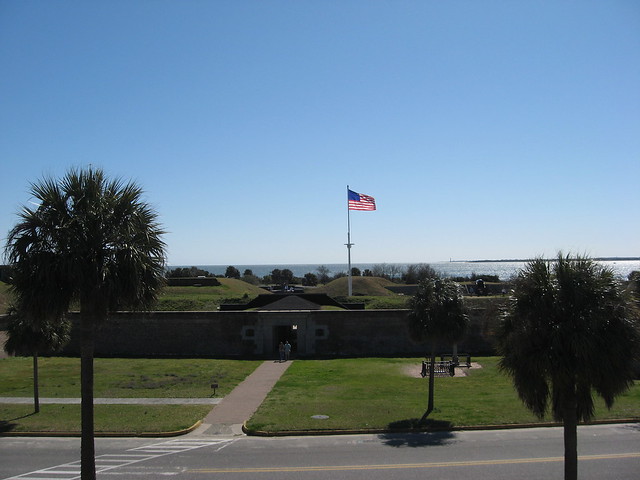
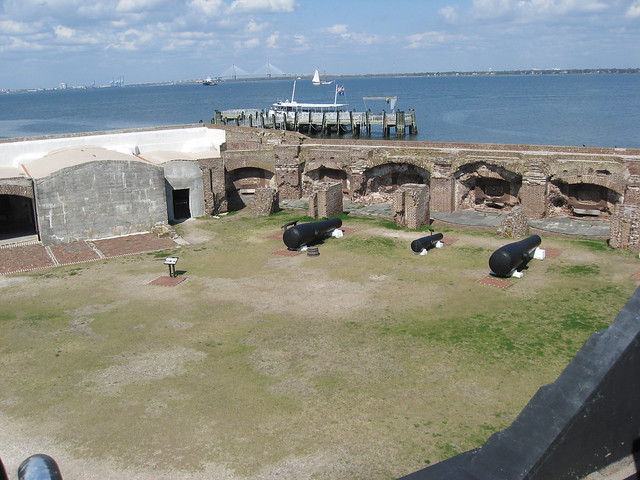

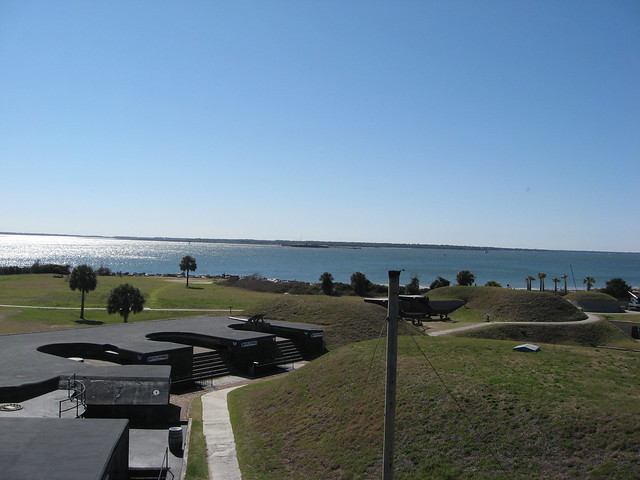
Further Reading:
Ok I don't have anything else to read as far as the geology goes but check out the NPS website on the sites to learn more about the history as well as many untold books on the Civil War itself.
National Park Service Series homepage
Monday, April 11, 2011
A Single Data Point!
Every winter it seems that the climate denialists bring out the but it's cold argument and while I have covered it before (see here, here, and here) I wanted to point out why it is not a valid argument against global climate change. I was inspired to do this based on a recent post over at Conservapedia which said the following [source]:
The problem with one cold month is that it is only one data point. Global climate change is based on a build up of data that spans decades of research. One or two colder than normal months out of decades do not influence the data to a great degree nor should they be considered proof of the end of climate change, these are what are typically referred to as weather. What Conservapedia and the climate change denialists are doing are cherry picking data. I can do the same thing, as a resident of Lubbock, TX I know last month was hot in fact there was a least one day that we set a new record high. What is more is that the National Weather Service agrees with me and therefore that link that conservapedia posted is completely wrong March was one of the top 15 warmest months on record for the area and therefore their view that global warming is not happening is wrong, and the fact that Texas is in a severe drought means that the whole state is going to run out of water forever (sorry I wanted to find a way to get that link in a post somewhere).
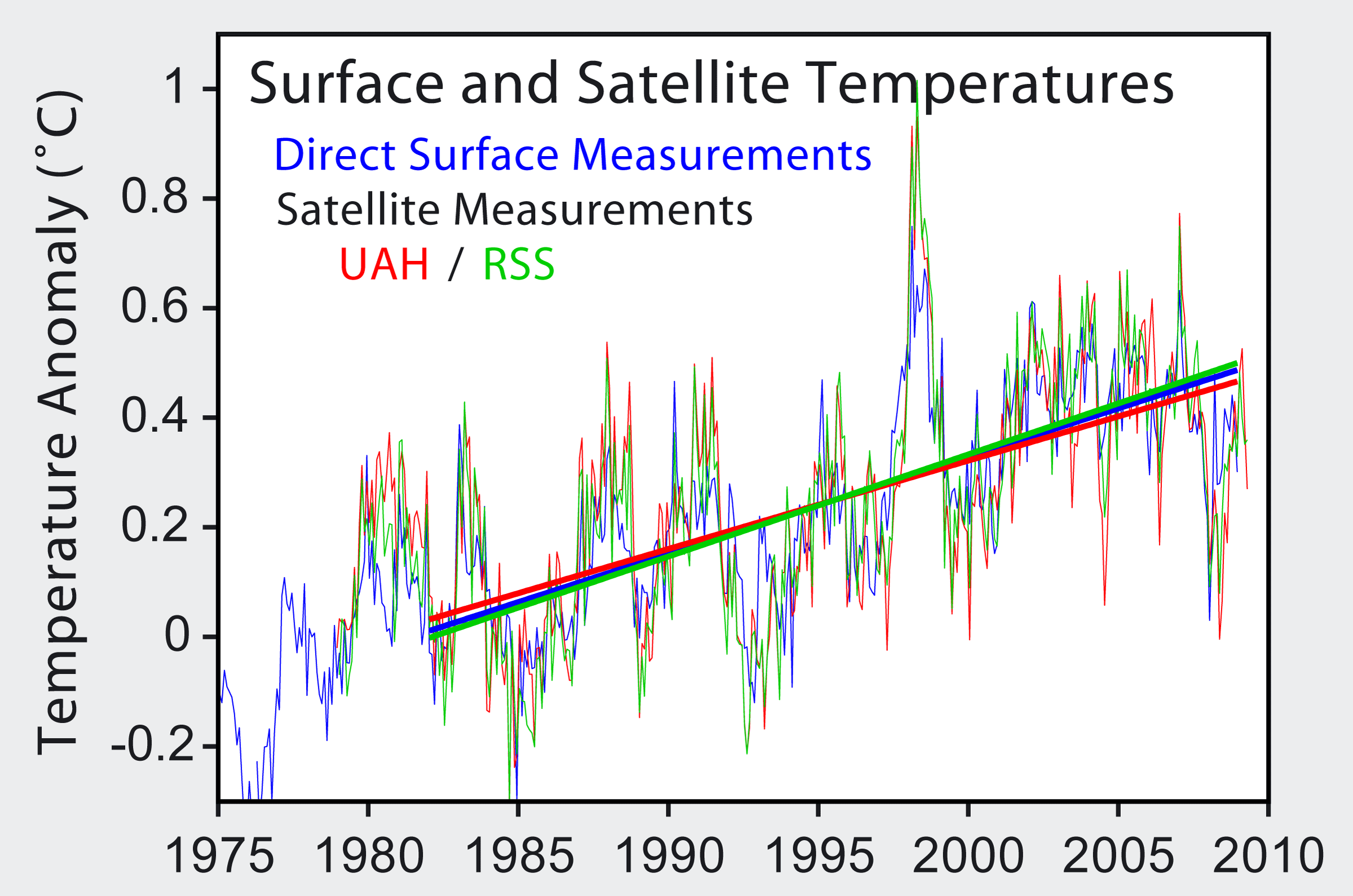 It doesn't work that way, in fact even 2010 being tied for the warmest on record isn't, by itself, important. What is important is the long term trends like the graph to the left which shows over the long term the temperatures have been increasing globally, from Wikipedia. If you go to NASA's climate change website you can see all of the data accumulated thus far showing that climate change is in fact happening. Climate scientists might even actually expect 2011 to be much cooler than 2010 (I don't know that they do this was more just an example), but this will not pronounce climate change dead but will in fact just say that temperatures will vary year to year in the same way that temperature varies day to day. These individual variations are not important again it will always be colder in January than in July in the northern hemisphere and some places will always see snow. What is important is the long term trend, this is what scientists are interested in and this is what they look at. As summarized here, yes I know it is Wikipedia but the summary is good, you can see that of the 20 warmest years the vast majority in the upper half are in the last decade, and here you can see that the last 3 decades have been the warmest decades with each being warmer than the last. That sort of information is important and how climate change is decided not, well it was cold today we should stop worrying.
It doesn't work that way, in fact even 2010 being tied for the warmest on record isn't, by itself, important. What is important is the long term trends like the graph to the left which shows over the long term the temperatures have been increasing globally, from Wikipedia. If you go to NASA's climate change website you can see all of the data accumulated thus far showing that climate change is in fact happening. Climate scientists might even actually expect 2011 to be much cooler than 2010 (I don't know that they do this was more just an example), but this will not pronounce climate change dead but will in fact just say that temperatures will vary year to year in the same way that temperature varies day to day. These individual variations are not important again it will always be colder in January than in July in the northern hemisphere and some places will always see snow. What is important is the long term trend, this is what scientists are interested in and this is what they look at. As summarized here, yes I know it is Wikipedia but the summary is good, you can see that of the 20 warmest years the vast majority in the upper half are in the last decade, and here you can see that the last 3 decades have been the warmest decades with each being warmer than the last. That sort of information is important and how climate change is decided not, well it was cold today we should stop worrying.
Global Warming Update: Cooling Trend Continues. March 2011 is on record as the coldest in 15 years. [14]I saw that post and said, "so?" but I realized that many people who read Conservapedia, then again I doubt many people who read Conservapedia read my blog, might not realize that one month being colder isn't important.
The problem with one cold month is that it is only one data point. Global climate change is based on a build up of data that spans decades of research. One or two colder than normal months out of decades do not influence the data to a great degree nor should they be considered proof of the end of climate change, these are what are typically referred to as weather. What Conservapedia and the climate change denialists are doing are cherry picking data. I can do the same thing, as a resident of Lubbock, TX I know last month was hot in fact there was a least one day that we set a new record high. What is more is that the National Weather Service agrees with me and therefore that link that conservapedia posted is completely wrong March was one of the top 15 warmest months on record for the area and therefore their view that global warming is not happening is wrong, and the fact that Texas is in a severe drought means that the whole state is going to run out of water forever (sorry I wanted to find a way to get that link in a post somewhere).
 It doesn't work that way, in fact even 2010 being tied for the warmest on record isn't, by itself, important. What is important is the long term trends like the graph to the left which shows over the long term the temperatures have been increasing globally, from Wikipedia. If you go to NASA's climate change website you can see all of the data accumulated thus far showing that climate change is in fact happening. Climate scientists might even actually expect 2011 to be much cooler than 2010 (I don't know that they do this was more just an example), but this will not pronounce climate change dead but will in fact just say that temperatures will vary year to year in the same way that temperature varies day to day. These individual variations are not important again it will always be colder in January than in July in the northern hemisphere and some places will always see snow. What is important is the long term trend, this is what scientists are interested in and this is what they look at. As summarized here, yes I know it is Wikipedia but the summary is good, you can see that of the 20 warmest years the vast majority in the upper half are in the last decade, and here you can see that the last 3 decades have been the warmest decades with each being warmer than the last. That sort of information is important and how climate change is decided not, well it was cold today we should stop worrying.
It doesn't work that way, in fact even 2010 being tied for the warmest on record isn't, by itself, important. What is important is the long term trends like the graph to the left which shows over the long term the temperatures have been increasing globally, from Wikipedia. If you go to NASA's climate change website you can see all of the data accumulated thus far showing that climate change is in fact happening. Climate scientists might even actually expect 2011 to be much cooler than 2010 (I don't know that they do this was more just an example), but this will not pronounce climate change dead but will in fact just say that temperatures will vary year to year in the same way that temperature varies day to day. These individual variations are not important again it will always be colder in January than in July in the northern hemisphere and some places will always see snow. What is important is the long term trend, this is what scientists are interested in and this is what they look at. As summarized here, yes I know it is Wikipedia but the summary is good, you can see that of the 20 warmest years the vast majority in the upper half are in the last decade, and here you can see that the last 3 decades have been the warmest decades with each being warmer than the last. That sort of information is important and how climate change is decided not, well it was cold today we should stop worrying.
Sunday, April 10, 2011
Creationism and Evolution in Public Schools
The Secular Student Society at Texas Tech (yes the website is out of date come on now guys) [prior post about them] is hosting an event that has been the focus of many posts on this blog, Creationism and Evolution in Public Schools. This event will be a talk by Dr. Michael Dini a professor of Biology, more specifically Biology Education, at Texas Tech University and will start on Monday April 11 at 8:00 pm in Holden Hall Room 150. This should be an interesting event because Texas has in the past been openly hostile to evolution and Lubbock is one of the more conservative cities in the country. I will be there and if this is a topic that interests you at all you should be there as well you are more than welcome.
Thursday, April 7, 2011
Wednesday, April 6, 2011
My Rock!!!
As a geologist I can relate to video, I have plenty of rocks myself. Let us just hope that the ASPCA doesn't consider rocks to be pets or they will be after me big time.
Sunday, April 3, 2011
Dr. Prothero on Earthquake Prediction
I have avoided talking about the horrible earthquake in Japan because there are much smarter people than I out there talking much better science than I could. I found one example in this past week's eSkeptic. The article written by Dr. Prothero, a geologist and vertebrate paleontologist at Occidental College in Los Angeles, takes on one of the worst offenders of passing off lies as science.
Among those that got their 15 minutes of fame during the post-quake media blitz was a well-known crank, Jim Berkland, who got a full interview promoting his ideas on Fox News on March 17 (but on no other network). First, the reporter put up a map of the “Ring of Fire” of volcanoes and earthquakes around the Pacific Rim, pointed at Chile, then New Zealand, then Japan, and implied that this circle of quakes might end in California. Apparently, he never consulted a geologist, who would have pointed out that each of those regions is an entirely different type of plate boundary and they have no tectonic plates in common. Then Fox gave Berkland a full five minutes to spout his ideas, with the same credulous reporter tossing him softball questions, and no rebuttal from any other geologist or seismologist.It is a good article and worth going to read the whole thing. I also want to note that Dr. Prothero is now blogging on the skeptic site so go follow him I am sure he will have some great posts in the future.
Friday, April 1, 2011
National Parks and Funding
This will probably one of the few posts where I will discuss politics but I will try to remain as neutral as possible but we all have to acknowledge that most things we read do have some sort of bias especially when it comes to things like the federal budget so I apologize in advance. If you have been following this blog for any length of time you probably have a good idea of how I feel about the National Park System here in the United States. If you are new here or have just missed it lets just say I started a series discussing the National Parks I visit for a reason. This is why on Tuesday, March 29th, when I picked up the Texas Tech school paper, the Daily Toreador (DT), and saw an opinion piece advocating for no cuts to the National Park Service budget. The article is well written, for an opinion article in a college paper, and expresses a lot of my views on the subject.
Now this next statement really got to me:
I am not going to address his last two paragraphs as they are purely political and I don't want to get into these statements here. Some other arguments have thankfully been put forth in a letter to the editor of the DT today, Friday April 1st, so go read those as well. Also I want to admit that there are reasons that you could justify cutting some money from the NPS and DOI but none of the above are them. Let me end with words that should probably be familiar to all, well at least those from the U.S., explain the need to protect a lot of these lands from President Abraham Lincoln.
People from around the world visit America’s national parks for a multitude of reasons. The parks offer unparalleled natural beauty, outstanding recreational activities, important historical preservation and education, and both mental and physical health improvement opportunities. Appropriating adequate funding to the national parks is essential to continue offering this to all Americans.I was happy to see something like this in the school paper but I was soon to be disappointed. The following day, Wednesday March 30th, I picked up the school paper again and when I got to the opinion page saw this letter to the editor. I was seriously disappointed by what the author had to say because he seemed to be drastically misinformed. So I am going to try to destruct a lot of his argument, let me make sure to preface this by saying my economic background is lacking and there will be a lot of statements from personal experience that may not apply to everyone but I feel that these will work best for the arguments that he makes. So lets get started shall we.
While the author looks at the benefits of national parks, he fails to realize what the costs are. The budget for national parks is close to $3 billion. However, if you look at the budget for the department that oversees national parks (Department of Interior), its budget authority for 2011 is $18 billion.$3 billion may sound like a lot of money but even when you compare it to the whole $18 billion for the Department of the Interior (DOI) that is really a small percentage. But let's expand this out, according to the New York Times, click the link for a really cool way to see where your money goes, the Federal Budget for 2010 was $3.60 trillion and President Obama's plan for 2011 is $3.69 trillion. So what does this mean? It means that if we cut all funding to the NPS you wouldn't see a change in either of those numbers. So how much percentage wise are we talking about, less than 1% of the federal budget for 2010 and in fact is less that 0.1% of the total budget. So we really won't save that much money if we cut the NPS out entirely.
Instead of spending money trying to conserve land and national resources, I would feel better auctioning off government-owned land, national parks and other resources. The federal government owns nearly 30 percent, or 650 million acres, of the United States.I included these two paragraphs together because lets face it they are arguing for the same thing. So his problem isn't with the NPS it is with the DOI, whose total operating budget is still less than 1% of the entire US Budget. These federal owned land which he feels should be sold include the National Parks but a far larger percentage of them belong to National Forests and National Grasslands, with some other land uses being by the BLM and Indian Reservations among others. National Forests and Grasslands are far from being just protected land they are land that the government allows for private use of. They do this by allowing logging and cattle grazing in these lands. Wait what? Yes that is right these lands can be used by private companies/individuals for logging and grazing but the government asks for a fee and that the land isn't overgrazed or clear cut. In order words they prevent private companies from destroying these resources for future use, so American will continue to have natural resources so we can continue to be a great country into the future, oh yeah and so we can continue to have clean drinking water.
Another solution proposed by Dr. Walter E. Williams of George Mason University is allowing people to exchange future Social Security benefits for government-owned land.
The author also mentions how national parks can promote exercise and education. Nature is not the only place to get physical exercise. Doing an intense cardiovascular workout would burn more calories than hours at a national park.Getting a 30 min "intense cardiovascular workout" may burn more calories in the short term, not that I am sure about this fact, but long hikes can build up endurance which means that you will have a better metabolism and be able to burn more calories sitting watching TV at the end of the day than if you just went to the gym. Also I feel the author has never hiked up a trail that included 2,000+ feet of elevation change over ~4 miles starting at ~1 mile above sea level, I loved the Guads, because trust me you are burning a ton of calories no matter who you are.
Now this next statement really got to me:
As for education, if people really wanted to get an understanding of history, they could spend an afternoon at the library or do online research.I can read about Gettysburg all I want, I can hear that the Confederates had to cross a mile of open field, uphill, till the cows come home, but until you are standing at the Confederate position in Gettysburg and you see how impossible it really was. You can "learn" history from books but you don't really know history till you can experience it yourself, see it for yourself. This also neglects the fact that many of these historical locations saw the deaths of thousands of American soldiers many of them were never identified and were buried in mass graves which are often lost to history. The only thing we know about these graves is that they were on the battlefields, these battlefields serve as reminders as well as graveyards. The Civil War battlefields of the east especially those around Washington D.C. have already been built up around and we have lost portions of history forever and we need it to stop.
I am not going to address his last two paragraphs as they are purely political and I don't want to get into these statements here. Some other arguments have thankfully been put forth in a letter to the editor of the DT today, Friday April 1st, so go read those as well. Also I want to admit that there are reasons that you could justify cutting some money from the NPS and DOI but none of the above are them. Let me end with words that should probably be familiar to all, well at least those from the U.S., explain the need to protect a lot of these lands from President Abraham Lincoln.
Four score and seven years ago our fathers brought forth on this continent a new nation, conceived in liberty, and dedicated to the proposition that all men are created equal.
Now we are engaged in a great civil war, testing whether that nation, or any nation, so conceived and so dedicated, can long endure. We are met on a great battle-field of that war. We have come to dedicate a portion of that field, as a final resting place for those who here gave their lives that that nation might live. It is altogether fitting and proper that we should do this.
But, in a larger sense, we can not dedicate, we can not consecrate, we can not hallow this ground. The brave men, living and dead, who struggled here, have consecrated it, far above our poor power to add or detract. The world will little note, nor long remember what we say here, but it can never forget what they did here. It is for us the living, rather, to be dedicated here to the unfinished work which they who fought here have thus far so nobly advanced. It is rather for us to be here dedicated to the great task remaining before us—that from these honored dead we take increased devotion to that cause for which they gave the last full measure of devotion—that we here highly resolve that these dead shall not have died in vain—that this nation, under God, shall have a new birth of freedom—and that government of the people, by the people, for the people, shall not perish from the earth.
Subscribe to:
Posts (Atom)



